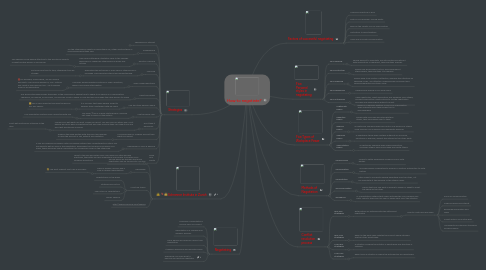
1. Strategies
1.1. Showing your interest
1.1.1. Simple phrases such as "yes," "OK" or "I see" effectively show you are paying attention. This encourages the other person to continue talking
1.2. Paraphrasing
1.2.1. Tell the other person what you heard them say, either quoting them or summarizing what they said
1.3. Emotion Labeling
1.3.1. This means attaching a tentative label to the feelings expressed or implied by other person's words and actions
1.3.1.1. This shows you are paying attention to the emotional aspects of what another person is conveying
1.4. Mirroring
1.4.1. Repeating the last words or main idea of other person's message. This indicates interest and understanding
1.4.1.1. But only from time to time, otherwise it will be strange
1.5. Open-ended questions
1.5.1. Use open-ended questions instead of "why" questions, which could imply interrogation
1.5.1.1. For example, avoid asking, “Do you offer a discount?” The obvious answer is, “No.” Instead say “What is your discount for…” as it requires more of an explanation
1.6. Effective pauses
1.6.1. Any good interviewer knows the power of the long silence. People tend to speak to fill spaces in a conversation. Therefore, you should, on occasion, consciously create a space or void that will encourage the other person to speak
1.7. Use the other person’s name
1.7.1. It is so basic that many people forget to address their counterpart with his name
1.7.1.1. This is very important because the person will feel special
1.8. Use the word "WE"
1.8.1. You know, $100 is a good starting place. Now we just need to work out the details.”
1.8.1.1. Your negotiation partner feels connected with you
1.9. Don’t take it personally
1.9.1. Maybe you’ll get what you want. Maybe you won’t. Life will move on either way. Most people will never have a negotiation that will make or break their life. Keep it real and don’t get emotionally involved
1.9.1.1. Don't get emotionally attached to the item
1.10. You should ask for a higher amount than what you expect
1.10.1. Address the issue politely with the client and ask him to raise the amount of fee, without any hesitation
1.11. Remember To Give & Receive
1.11.1. If you are offering concession after concession without any commitments in return you are going to get run over in the negotiation. Remember that for each concession you make, there should be some commitment or concession made on the other side.
1.12. Close Your Mouth
1.12.1. Learn to talk less and listen more. The more you listen and ask questions, the better you will understand and be able to position your company effectively
2. Negotiating
2.1. The basis of negotiations is some form of conflict
2.2. Negotiation is a complex and dynamic process
2.3. Many people are afraid of conflict and negotiation
2.4. It requires behavioral and analytical skills
2.5. Everybody can learn how to become an effective negotiator
3. Schranner Institute in Zurich
3.1. We are driven by the idea that every negotiation can be turned into a victory
3.2. Philosophy
3.2.1. There is always a winner and a loser in difficult negotiations
3.2.1.1. "We want support you to be a WINNER"
3.3. 4 Lecture topics
3.3.1. Negotiations on the Edge
3.3.2. Strategy and Tactics
3.3.3. The Future of Negotiations
3.3.4. Dinner Speech
3.4. http://www.schranner.com/speech
4. Five Personal styles in negotiating
4.1. Self-denying
4.1.1. People difficult to negotiate, are introverted and reticent with information or feedback, they hide their feelings
4.2. Self-protecting
4.2.1. People use diversionary tactics, discussing about other people, they hide their true feelings
4.3. Self-exposing
4.3.1. People wish to be center of attention, demand this attention by speaking loudly, use attention-seeking body movement and ignoring feedback and other’s view
4.4. Self-bargaining
4.4.1. People show feeling if you show yours
4.5. Self-actualizing
4.5.1. Ideal negotiators, want information and feedback from others, present information constructively to aid the negotiation process and achieve goal without conflict
5. Five Types of Workplace Power
5.1. Legitimate power
5.1.1. Bases on a persons position or role in an organization. Their authority gives them power that is acknowledged
5.2. Expertise power
5.2.1. People with more skill and strength than others, their colleagues refer to them
5.3. Reward power
5.3.1. Is exerted by someone who has control over desires of others. Such a person can influence and manipulate behavior
5.4. Coercive power
5.4.1. Is exerted by those who use their authority or any force, emotional or physical, against the interest of the other party
5.5. Consultative power
5.5.1. Is exerted by someone who seeks information, considers other’s advice and make plans with others
6. Methods of Negotiation
6.1. Compromise
6.1.1. Means to settle differences made by one or both parties
6.2. Collaboration
6.2.1. Involves people cooperating to produce a solution satisfactory to both parties
6.3. Competition
6.3.1. Often leads to one party gaining advantage over the other, if it can negotiate at the expense of the other’s needs
6.4. Accommodation
6.4.1. Means that only one party is willing to oblige or adapt to meet the needs of the other
6.5. Avoidance
6.5.1. Is a negotiation method that makes both parties lose, because one party retracts their point of view or backs away from the situation
7. Conflict resolution process
7.1. Win-win strategies
7.1.1. Both parties are satisfied with the settlement negotiated
7.1.1.1. How to create win win deals
7.1.1.1.1. Focus on communalities
7.1.1.1.2. Address needs and interest
7.1.1.1.3. Exchange information and ideas
7.1.1.1.4. Invent options for mutual gain
7.1.1.1.5. Use objective criteria for standards of performance
7.2. Win-lose strategies
7.2.1. Result in the party who initiates the conflict being satisfied and the other dissatisfied
7.3. Lose-win strategies
7.3.1. A situation in which the initiator is dissatisfied and the other is satisfied
7.4. Lose-lose strategies
7.4.1. Result form a situation in which the both parties are dissatisfied
